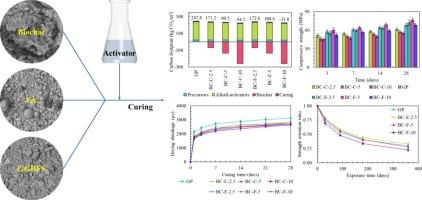废弃桉树衍生生物炭在可持续低碳和负碳地聚合物中的应用:干燥收缩率、机械性能和耐酸性能
IF 4.6
2区 工程技术
Q2 ENGINEERING, CHEMICAL
引用次数: 0
摘要
由于高多孔性、轻质性和负碳性,生物炭可以作为可持续地聚合物生产的内部固化剂。本文研究了用粗(1.18 mm)和细(0.425 mm)桉树衍生生物炭引入并在40和80°C下固化的地聚合物浆料的干燥收缩率、机械性能和耐酸性能。粗大生物炭的包合使地聚合物的强度下降,尽管固化温度不高。在40°C和80°C下,28天的干燥收缩率分别降低了13.2% ~ 15.9%和3.8% ~ 5.4%。添加2.5%和5%的细生物炭,在40℃下养护,抗压强度分别提高6%和12%。添加2.5%的细生物炭可使材料的抗弯强度提高5%。力学性能的提高与生物炭的内部固化效应引起的地聚合作用的改善有关,这可以通过微观结构分析来验证。经5%硫酸处理360天后,含有2.5%细生物炭的样品质量损失较小,抗压强度增加,强度保留率提高。含2.5%生物炭的地聚合物碳排放量降低27.9% ~ 30.9%。将生物炭添加量增加到10%产生负碳地聚合物(- 34.5至- 10.9 kg CO2/m3)。上述结果表明,在地聚合物中加入生物炭可能是一种可行的解决方案,可以生产出具有改善收缩、机械和耐用性能的低碳地聚合物。本文章由计算机程序翻译,如有差异,请以英文原文为准。

Application of waste Eucalyptus-derived biochar for sustainable low-carbon and carbon-negative geopolymer: Drying shrinkage, mechanical performance, and acid resistance
Due to the highly porous, lightweight, and carbon-negative nature, biochar can be potentially used as an internal curing agent for sustainable geopolymer production. This paper studied the drying shrinkage, mechanical behaviour, and acid resistance of geopolymer pastes introduced with coarse (1.18 mm) and fine (0.425 mm) Eucalyptus-derived biochar and cured under 40 and 80 °C. The inclusion of coarse biochar declined the strength of the geopolymer despite the curing temperatures. The 28-day drying shrinkage was mitigated by 13.2 % to 15.9 % and 3.8 % to 5.4 % under 40 and 80 °C curing, respectively. The introduction of 2.5 % and 5 % fine biochar under 40 °C curing increased the compressive strength by 6 % and 12 %, respectively. The flexural strength was enhanced by 5 % with 2.5 % fine biochar. The enhancements in the mechanical performance were associated with the improved geopolymerisation induced by the internal curing effects of biochar, which can be verified by the microstructure analysis. After being exposed to 5 % sulfuric acid for 360 days, the samples with 2.5 % fine biochar demonstrated less mass loss, increased compressive strength, and improved strength retention ratio. The carbon emissions of the geopolymer were reduced by 27.9 % to 30.9 % with 2.5 % biochar. Increasing dosages of biochar to 10 % produced carbon-negative geopolymer (−34.5 to −10.9 kg CO2/m3). The above results indicated that incorporating biochar in geopolymer could potentially be a viable solution to produce low-carbon geopolymer with improved shrinkage, mechanical, and durability properties.
求助全文
通过发布文献求助,成功后即可免费获取论文全文。
去求助
来源期刊

Powder Technology
工程技术-工程:化工
CiteScore
9.90
自引率
15.40%
发文量
1047
审稿时长
46 days
期刊介绍:
Powder Technology is an International Journal on the Science and Technology of Wet and Dry Particulate Systems. Powder Technology publishes papers on all aspects of the formation of particles and their characterisation and on the study of systems containing particulate solids. No limitation is imposed on the size of the particles, which may range from nanometre scale, as in pigments or aerosols, to that of mined or quarried materials. The following list of topics is not intended to be comprehensive, but rather to indicate typical subjects which fall within the scope of the journal's interests:
Formation and synthesis of particles by precipitation and other methods.
Modification of particles by agglomeration, coating, comminution and attrition.
Characterisation of the size, shape, surface area, pore structure and strength of particles and agglomerates (including the origins and effects of inter particle forces).
Packing, failure, flow and permeability of assemblies of particles.
Particle-particle interactions and suspension rheology.
Handling and processing operations such as slurry flow, fluidization, pneumatic conveying.
Interactions between particles and their environment, including delivery of particulate products to the body.
Applications of particle technology in production of pharmaceuticals, chemicals, foods, pigments, structural, and functional materials and in environmental and energy related matters.
For materials-oriented contributions we are looking for articles revealing the effect of particle/powder characteristics (size, morphology and composition, in that order) on material performance or functionality and, ideally, comparison to any industrial standard.
 求助内容:
求助内容: 应助结果提醒方式:
应助结果提醒方式:


